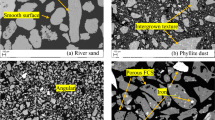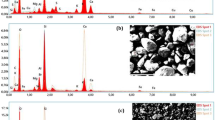Abstract
Among the actions proposed by the European Union for the implementation of Circular Economy is the use of waste as a secondary raw material (SRM). During the fusion of the scrap, a steel dust is generated, named electric arc furnace dust (EAFD). The EAFD is composed mainly of potentially leachable heavy metals and is classified as a “hazardous” waste. Worldwide, approximately 70% of EAFD is deposited in landfills, with a previous treatment through cement-based materials to prevent the metals’ mobility. However, this action is not in accordance with the Circular Economy concept. The present investigation analyses the use of EAFD as SRM in conventional mortar production for its use as a construction material. Different substitution percentages (25, 50 and 100%) were used replacing the siliceous filler by EAFD. A preceding characterisation of the waste by X-ray fluorescence, X-ray diffraction, specific surface area, bulk density, electron microscopy and particle size distribution was performed. The investigation analysed the behaviour of conventional mortars by tests of workability, compressive strength, mineralogy, water absorption by capillarity, and leaching behaviour in granular and monolithic states. The results obtained indicate a slight improvement in mechanical behaviour with the incorporation of EAFD, the reason why its use as SRM in conventional mortars would benefit the construction industry and would encourage the Circular Economy. From an environmental point of view, the mechanisms of Pb fixation should be improved in a granular state.










Similar content being viewed by others
References
AENOR (2017) Asociación Española de Normalización y Certificación, AENOR, Madrid, Spain, www.aenor.es. Accessed 15 Feb 2019
AFNOR (2017) Association française de Normalisation, www.afnor.org. Accessed 15 Feb 2019
Alizadeh M, Momeni M (2016) The effect of the scrap/DRI ratio on the specification of the EAF dust and its influence on mechanical properties of the concrete treated by its dust. Constr Build Mater 112:1041–1045. https://doi.org/10.1016/j.conbuildmat.2016.03.011
Alsheyab MAT, Khedaywi TS (2013) Effect of electric arc furnace dust (EAFD) on properties of asphalt cement mixture. Resour Conserv Recycl 70:38–43. https://doi.org/10.1016/j.resconrec.2012.10.003
Al-Zaid RZ, Al-Sugair FH, Al-Negheimish AI (1997) Investigation of potential uses of electric-arc furnace dust (EAFD) in concrete. Cem Concr Res 27(2):267–278. https://doi.org/10.1016/S0008-8846(96)00204-9
Balderas A, Navarro H, Flores-Velez LM, Dominguez O (2001) Properties of Portland cement pastes incorporating nanometer-sized franklinite particles obtained from electric-arc-furnace dust. J Am Ceram Soc 84(12):2909–2913
Brehm FA, Moraes CAM, Modolo RCE, Vilela ACF, Dal Molin DCC (2017) Oxide zinc addition in cement paste aiming electric arc furnace dust (EAFD) recycling. Constr Build Mater 139:172–182. https://doi.org/10.1016/j.conbuildmat.2017.02.026
Castellote M, Menendez E, Andrade C, Zuloaga P, Navarro M, Ordonez M (2004) Radioactively contaminated electric arc furnace dust as an addition to the immobilization mortar in low- and medium-activity repositories. Environ Sci Technol 38(10):2946–2952. https://doi.org/10.1021/es034518p
Chen QY, Tyrer M, Hills CD, Yang XM, Carey P (2009) Immobilisation of heavy metal in cement-based solidification/stabilisation: a review. Waste Manag 29(1):390–403. https://doi.org/10.1016/j.wasman.2008.01.019
Cholake ST, Farzana R, Numata T, Sahajwalla V (2018) Transforming electric arc furnace waste into value added building products. J Clean Prod 171:1128–1139. https://doi.org/10.1016/j.jclepro.2017.10.084
COM(2015)614 (2015) European Commission, Report from the commission to the European parliament, the council, the European Economic and Social Committee and the Committee of the Regions on the action plan for the circular economy
da Silva Magalhães M, Faleschini F, Pellegrino C, Brunelli K (2017) Cementing efficiency of electric arc furnace dust in mortars. Constr Build Mater 157(Supplement C):141–150. https://doi.org/10.1016/j.conbuildmat.2017.09.074
de Paula LN, Giusto LA, Rodrigues RC, Castilho LR, Magalhaes F, Rosmaninho MG et al (2013) Modification and characterization of residue electric arc furnace dust (EAFD) for application in chromium (VI) reduction reactions. Quím Nova 36(9):1332–1337
de Souza CAC, Machado AT, Lima L, Cardoso RJC (2010) Stabilization of electric-arc furnace dust in concrete. Mater Res Ibero Am J 13(4):513–519
de Vargas AS, Masuero AB, Vilela ACF (2006) Investigations on the use of electric-arc furnace dust (EAFD) in pozzolan-modified Portland cement I (MP) pastes. Cem Concr Res 36(10):1833–1841. https://doi.org/10.1016/j.cemconres.2006.06.003
Dutra AJB, Paiva PRP, Tavares LM (2006) Alkaline leaching of zinc from electric arc furnace steel dust. Miner Eng 19(5):478–485. https://doi.org/10.1016/j.mineng.2005.08.013
EEA (2010) English Environmental Agency. https://www.gov.uk/government/uploads/system/uploads/attachment_data/file/296422/geho1110btew-e-e.pdf. Accessed 21 Nov 2018
EU (2003) European Council decision for the acceptance of waste at landfills. http://eur-lex.europa.eu/LexUriServ/LexUriServ.do?uri=OJ:L:2003:011:0027:0049:EN:PDF. Accessed 20 Nov 2018
Fares G, Al-Zaid RZ, Fauzi A, Alhozaimy AM, Al-Negheimish AI, Khan MI (2016) Performance of optimized electric arc furnace dust-based cementitious matrix compared to conventional supplementary cementitious materials. Constr Build Mater 112:210–221. https://doi.org/10.1016/j.conbuildmat.2016.02.068
Hamilton IW, Sammes NM (1999) Encapsulation of steel foundry bag house dusts in cement mortar. Cem Concr Res 29(1):55–61. https://doi.org/10.1016/S0008-8846(98)00169-0
Hekal EE, Abo-El-Enein SA, El-Korashy SA, Megahed GM, El-Sayed TM (2013) Utilization of electric arc furnace dust as an admixture to Portland cement pastes. J Therm Anal Calorim 114(2):613–619. https://doi.org/10.1007/s10973-013-2992-8
Issa H, Korac M, Gavrilovski M, Pavlovic M, Kamberovic Z (2012) Possibility of carbon steel EAFD solidification/stabilization in concrete. Rev Chim 63(10):1008–1012
JCPD (1995) Joint committee on power diffraction standard-international centre for diffraction data. Swarthmore
Kuo Y-L, Huang W-C, Tseng Y-H, Chang S-H, Ku Y, Lee H-Y (2018) Electric arc furnace dust as an alternative low-cost oxygen carrier for chemical looping combustion. J Hazard Mater 342:297–305. https://doi.org/10.1016/j.jhazmat.2017.08.024
Laforest G, Duchesne J (2007) Investigation of stabilization/solidification for treatment of electric arc furnace dust: dynamic leaching of monolithic specimens. Cem Concr Res 37(12):1639–1646. https://doi.org/10.1016/j.cemconres.2007.08.025
Leclerc N, Meux E, Lecuire JM (2002) Hydrometallurgical recovery of zinc and lead from electric arc furnace dust using mononitrilotriacetate anion and hexahydrated ferric chloride. J Hazard Mater 91(1–3):257–270. https://doi.org/10.1016/s0304-3894(01)00394-6
Ledesma EF, Jimenez JR, Ayuso J, Fernandez JM, de Brito J (2017) Experimental study of the mechanical stabilization of electric arc furnace dust using fluid cement mortars. J Hazard Mater 326:26–35. https://doi.org/10.1016/j.jhazmat.2016.11.051
Ledesma EF, Lozano-Lunar A, Ayuso J, Galvín AP, Fernández JM, Jiménez JR (2018) The role of pH on leaching of heavy metals and chlorides from electric arc furnace dust in cement-based mortars. Constr Build Mater 183:365–375. https://doi.org/10.1016/j.conbuildmat.2018.06.175
Lozano-Lunar A, Raposeiro da Silva P, de Brito J, Fernández JM, Jiménez JR (2019) Safe use of electric arc furnace dust as secondary raw material in self-compacting mortars production. J Clean Prod 211:1375–1388. https://doi.org/10.1016/j.jclepro.2018.12.002
Maslehuddin M, Awan FR, Shameem M, Ibrahim M, Ali MR (2011) Effect of electric arc furnace dust on the properties of OPC and blended cement concretes. Constr Build Mater 25(1):308–312. https://doi.org/10.1016/j.conbuildmat.2010.06.024
Mitrakas MG, Sikalidis CA, Karamanli TP (2007) Immobilization of EAFD heavy metals using acidic materials. J Environ Sci Health A Tox Hazard Subst Environ Eng 42(4):535–541. https://doi.org/10.1080/10934520701189794
Navarro A, Cardellach E, Corbella M (2011) Immobilization of Cu, Pb and Zn in mine-contaminated soils using reactive materials. J Hazard Mater 186(2–3):1576–1585. https://doi.org/10.1016/j.jhazmat.2010.12.039
Oustadakis P, Tsakiridis PE, Katsiapi A, Agatzini-Leonardou S (2010) Hydrometallurgical process for zinc recovery from electric arc furnace dust (EAFD): part I: characterization and leaching by diluted sulphuric acid. J Hazard Mater 179(1):1–7
Sapiña M, Jimenez-Relinque E, Castellote M (2014) Turning waste into valuable resource: potential of electric arc furnace dust as photocatalytic material. Environ Sci Pollut Res 21(20):12091–12098. https://doi.org/10.1007/s11356-014-3167-2
Sayadi M, Hesami S (2017) Performance evaluation of using electric arc furnace dust in asphalt binder. J Clean Prod 143:1260–1267. https://doi.org/10.1016/j.jclepro.2016.11.156
Sebag MG, Korzenowski C, Bernardes AM, Vilela AC (2009) Evaluation of environmental compatibility of EAFD using different leaching standards. J Hazard Mater 166(2–3):670–675. https://doi.org/10.1016/j.jhazmat.2008.11.125
Tashiro C, Oba J (1979) Effects of Cr2O3, Cu(OH)2, ZnO and PbO on the compressive strength and the hydrates of the hardened C3A paste. Cem Concr Res 9(2):253–258. https://doi.org/10.1016/0008-8846(79)90032-2
van der Sloot H, Dijkstra J (2004) Development of horizontally standardized leaching tests for construction materials: a material based or release based approach? Identical leaching mechanisms for different materials. ECN-C--04-060. http://www.ecn.nl/docs/library/report/2004/c04060.pdf. Accessed 14 Oct 2018
Yousuf M, Mollah A, Vempati RK, Lin TC, Cocke DL (1995) The interfacial chemistry of solidification/stabilization of metals in cement and pozzolanic material systems. Waste Manag 15(2):137–148. https://doi.org/10.1016/0956-053X(95)00013-P
Acknowledgments
This investigation was partly supported by the Andalusian Regional Government (Research Groups TEP-227 and FQM-391) and by the XXI Own Program for the Promotion of Research at the University of Córdoba - Modality 4.2. (FEDER). The authors would like to thank the public company ENRESA for financial support on this research via project (035-ES-IN-0140). The authors wish to thank the staff at the Central Research Support Service (SCAI) and the Fine Chemistry Institute of the University of Córdoba for the assistance and technical support.
Funding
XXI Own Program for the Promotion of Research at the University of Córdoba - Modality 4.2. (FEDER). MECD-Spain (http://www.mecd.gob.es/educacion-mecd/) FPU14/05245. ENRESA via project (035-ES-IN-0140).
Author information
Authors and Affiliations
Corresponding authors
Ethics declarations
Conflicts of interest
The authors declare that they have no conflict of interest.
Additional information
Responsible editor: Philippe Loubet
Publisher’s note
Springer Nature remains neutral with regard to jurisdictional claims in published maps and institutional affiliations.
Rights and permissions
About this article
Cite this article
Lozano-Lunar, A., Barbudo, A., Fernández, J.M. et al. Promotion of circular economy: steelwork dusts as secondary raw material in conventional mortars. Environ Sci Pollut Res 27, 89–100 (2020). https://doi.org/10.1007/s11356-019-04948-y
Received:
Accepted:
Published:
Issue Date:
DOI: https://doi.org/10.1007/s11356-019-04948-y




